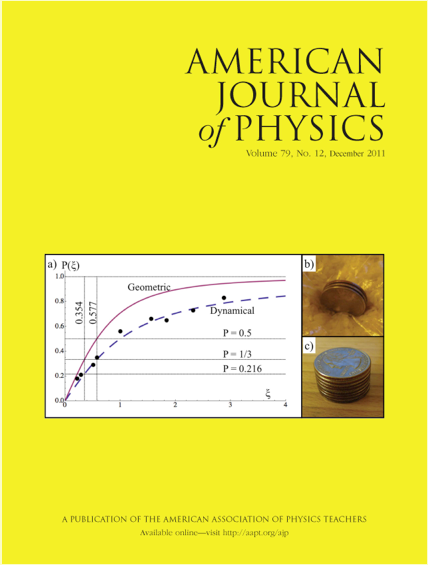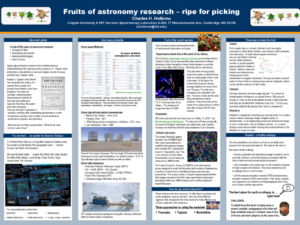Zeng: Representation of Sound Standing Waves in a Pipe
Cardamone, et al.: Item Response Theory Analysis of the Mechanics Baseline Test
Lewis: Laboratory Experiences in Astrophysics for Junior Lab
Tuttle: Modest Aperture Astrophysical Projects
Vondruska, et al.: Cosmic Math
Gordon Conference Meeting Description
Meeting Description
“Astronomy’s Discoveries and Physics Education” is the title of the 2012 Physics Research and Education Gordon Research Conference. At this GRC a distinguished group of speakers will review major discoveries and technologies of astronomy and astrophysics. They and members of the astronomy and physics education research communities will also explore and suggest ways to use this material to enrich and enhance undergraduate physics education. As with all GRCs, advancing research frontiers is an important goal, but, in addition, this conference seeks to motivate participants to create astronomy-based teaching materials that will convey to students the excitement of these frontiers and also entice physicists to use them as contexts for teaching physics in their undergraduate courses. The conference’s format—invited plenary sessions, contributed poster presentations, and generous amounts of unscheduled time for informal discussions—promotes dialogue and cross-fertilization of ideas between educators and researchers at the forefront of their fields.
Who should participate? You… if you’re interested in fostering the use of astronomy’s discoveries to better teach physics to undergraduates. If this challenge attracts you – whether you are an active researcher in astronomy, astrophysics, or space science, or a research associate (postdoc), or an author of books that present physics in a strong astronomy context, or a developer of curricula and educational materials, or a graduate or undergraduate student, or a two-year or four-year college or university faculty member with an interest in physics and astronomy – apply to attend this Gordon Conference on “Astronomy’s Discoveries and Physics Education.”
AJP Theme Issue
The May 2012 issue of the American Journal of Physics was devoted to papers relevant to the use of astronomy and space science research in physics courses.

Decades of research in physics, astronomy, and space science have led to remarkable new instruments and technologies and astonishing discoveries. This theme issue harvests some of this abundance and shows some of the problems of using it to enliven and update physics instruction.
The papers in this issue are based on achievements of astronomy and space science research. They challenge us to use their underlying physics for effective and engaging physics instruction.
The theme issue implicitly challenges Continue reading “AJP Theme Issue”
AAS Special Session — May 2011
Using the Discoveries of Astronomy to Teach Physics
Special Session at the 218th national meeting of the AAS, Boston, MA, May 22-26, 2011
Chair: Charles H. Holbrow, Colgate University & MIT

GRC: Astronomy’s Discoveries & Physics Education
- Astronomy’s discoveries and physics education
- Gordon Conference Meeting Description
- Gordon Conference Program
- Fresh Perspectives
 The 2012 Gordon Research Conference: Physics Research & Education explored astronomy research results and how they can be used to enrich physics instruction. The 2012 Gordon Research Conference: and how they can be used to enrich physics instruction. The conference was held June 17-22, 2012 at Colby College in Waterville, ME.
The 2012 Gordon Research Conference: Physics Research & Education explored astronomy research results and how they can be used to enrich physics instruction. The 2012 Gordon Research Conference: and how they can be used to enrich physics instruction. The conference was held June 17-22, 2012 at Colby College in Waterville, ME.
Like all Gordon Conferences this one provided participants a chance to try out and to hear new ideas in a relaxed and pleasant environment. GRC:PRE–2012 also offered the broader perspective that comes from participants active in a variety of areas of astronomy and physics.
Visit the Gordon Research Conference website to learn more.
Richard Gelderman: Image Analysis Software: alternatives to IRAF
Richard Gelderman, Western Kentucky University
Image Analysis Software: alternatives to IRAF
Learning physics is best done by direct participation in the full cycle of the scientific process, with emphasis on open-ended investigation. Astronomical investigations typically involve imaging data, most often collected in FITS format. Given the steep learning curve for IRAF, IDL, or other tools of the professional astronomer, the question at hand is: What is the best software package for analysis of FITS images?
There are proprietary packages that are very good, but can be expensive (e.g., AIP4WIN, MaximDL, etc.). A freely downloadable option is ImageJ, the versatile, mulitiplatform, and freely downloadable Java port of the NIH Image platform. However, ImageJ requires plugins before simple tasks like aperture photometry and astrometry can be readily accomplished.
My recommendation is Salsa J — a powerful image processing software suite based on ImageJ and distributed by European Hands-On Universe (www.euhou.net –> software –> SalsaJ software: Download). This software provides most of the capability of IRAF, but with a user-friendly, shallow learning-curve graphical interface allows educators to build curriculum content while using real research methodology.

